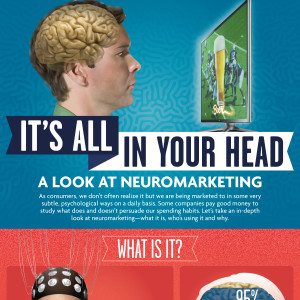Share this infographic on your site!
It’s All in Your Head: A Look at Neuromarketing
As consumers, we don’t often realize it but we are being marketed to in some very subtle, psychological ways on a daily basis. Some companies pay good money to study what does and doesn’t persuade our spending habits. Let’s take an in-depth look at neuromarketing — what it is, who’s using it and why.
What Is It?
Neuromarketing is a field of marketing that studies human cognitive responses to stimuli in order to create effective commercial campaigns. (1)
95% of consumers’ decision-making takes place in the subconscious mind. (1)
Subconscious thought processing is 200,000 times faster than conscious thought processing. Close to 11 million bits per second. (1)
70%
Percentage of fast-moving consumer goods (FMCG) purchases made “at the shelf” (1)
80%
Percentage of new product launches that fail to meet predicted sales or performance within the first 3 months (1)
Neuromarketing Tips
Here are some tips to help make your company’s marketing campaigns reach more consumers effectively. (4)
It’s not all about you. Spend more time talking about the customers’ needs than your own brand.
Longer isn’t better. Short, impactful statements are more likely to stick to consumers.
The average person has an attention span of 8 seconds. (2)
Show, don’t tell. Photos are better at selling products than words.
65% of people are visual learners. (3)
Start off strong, finish big. Brains tend to remember beginnings and endings rather than middles.
Keep it simple. Clever abstractions or too many numbers will only confuse consumers.
Appeal to emotion. The most effective way to market is to use pathos, an appeal to consumers’ emotions, and it will always override intellect or reason.
Success Stories
Microsoft
Using EEG, or electroencephalography, Microsoft monitored brain activity of users during their interaction with computers in order to determine what gave them feelings of surprise, satisfaction and frustration.(4)
Frito-Lay
While studying the female brain, the successful snack company discovered that using the term “guilt,” as in descriptors like “guilt-free snacking,” is ineffective marketing. They have since changed to using the word “healthy.” (4)
Google
While partnering with MediaVest, Google used biometrics to measure the effectiveness of two different types of advertisement on YouTube: overlays versus pre-rolls. Overlays, like banners, were found to be much more effective. (4)
Daimler-Chrysler
Daimler used fMRI, or Functional Magnetic Resonance Imaging, technology for a study that had men ranking the aesthetic attractiveness of cars. (4,5)
The Weather Channel
Using EEG, eye-tracking and skin response technology, TWC measured viewer reactions to various promotional pitches for popular series. (4)
Careers That Use Neuromarketing
Becoming a specialist in neuromarketing can pave the way for some fairly lucrative, in-demand careers.(6)
Client managers
What they do: Work with clients to develop business campaigns, approaches, finances and usable data.
Median salary: $116,010
Neuromarketing consultants
What they do: Provide consultation to marketing companies for branding based on neural and sensory studies.
Median salary: $78,160
Market research analysts
What they do: Conduct research using customer data and make recommendations to clients.
Median salary: $60,570

Sources:
2.
http://www.telegraph.co.uk
3.
http://visualteachingalliance.com
4.
http://www.fastcompany.com
5.
http://theconversation.com
6.
http://www.marketing-schools.org
 Sources:
2. http://www.telegraph.co.uk
3. http://visualteachingalliance.com
4. http://www.fastcompany.com
5. http://theconversation.com
6. http://www.marketing-schools.org
Sources:
2. http://www.telegraph.co.uk
3. http://visualteachingalliance.com
4. http://www.fastcompany.com
5. http://theconversation.com
6. http://www.marketing-schools.org

